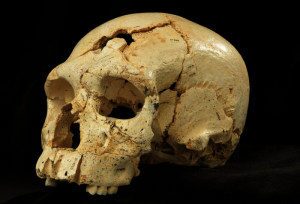
The recent recovery and analysis of 17 early human fossil skulls from the Sima de los Huesos (“Pit of Bones”) cave pit site in the Sierra de Atapuerca cave system of northern Spain have illuminated our understanding of how Neandertals, a more ancient, extinct sister species of Homo sapiens (modern humans), actually evolved, according to a study report published this week in Science.
Currently led by Juan Luis Arsuaga of the Universidad Complutense de Madrid, Spain, archaeological teams have been excavating at the site for four decades, and have recovered the largest assemblage of early human fossils ever discovered at any one site in the world.
“After thirty years, we have recovered nearly 7,000 human fossils corresponding to all skeletal regions of at least 28 individuals,” says study co-author Ignacio Martinez, Professor of Paleontology at the University of Alcalá. “This extraordinary collection includes 17 fragmentary skulls, many of which are very complete.”
The 17 skulls, according to the researchers, represent a single population of a hominin (early human) species. Although some of have been studied before, seven are presented anew here, and six are more complete than ever before, after many hours of painstaking assemblage in the lab. Now, with the mostly intact samples for study, the researchers have been able to more clearly define the common features of what they believe to be a single population.
______________________________________
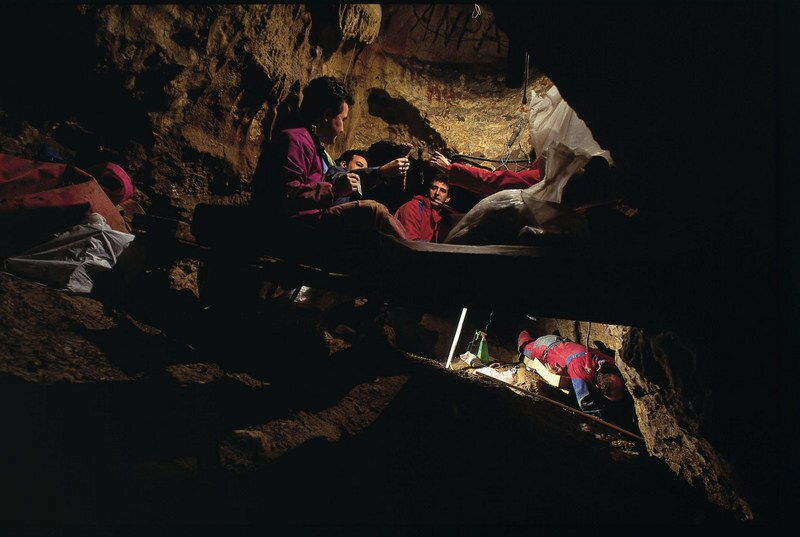 The Sima de los Huesos site. Image courtesy Javier Trueba / Madrid Scientific Films
The Sima de los Huesos site. Image courtesy Javier Trueba / Madrid Scientific Films
_______________________________________
The fossils exhibited a mosaic of physical characteristics that could not be wholly attributed to any single, recognized human species to date. The skull samples showed clear Neandertal features in the face and teeth. The researchers suggest these ‘Neandertal-derived’ features were functionally related to mastication, or chewing. “It seems these modifications had to do with an intensive use of the frontal teeth,” Arsuaga said. “The incisors show a great wear as if they had been used as a ‘third hand,” typical of Neanderthals.” But elsewhere, the skulls showed characteristics that diverted from the Neandertal model. The braincase itself, for example, still showed features associated with more primitive hominins.
_______________________________________
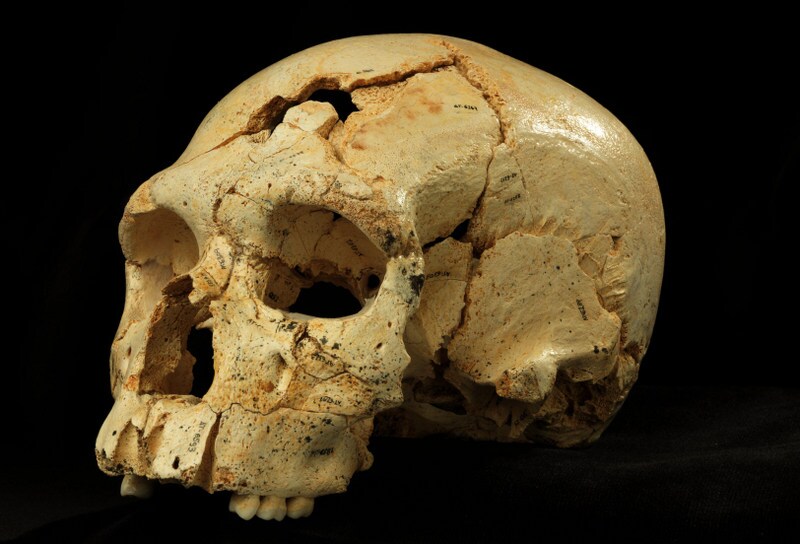 Skull 17 from the Sima de los Huesos site in Sierra de Atapuerca, Spain. Image courtesy Javier Trueba / Madrid Scientific Films
Skull 17 from the Sima de los Huesos site in Sierra de Atapuerca, Spain. Image courtesy Javier Trueba / Madrid Scientific Films
____________________________________
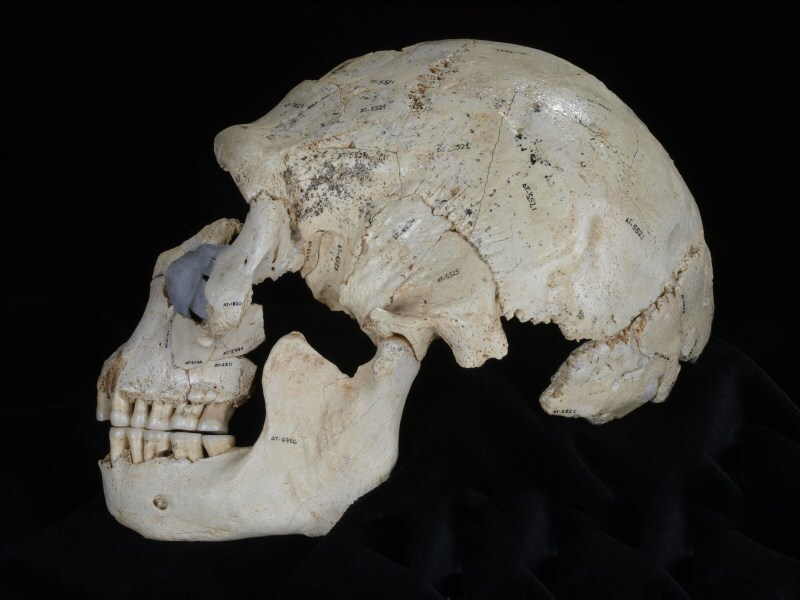 Skull 15. Image courtesy Javier Trueba / Madrid Scientific Films
Skull 15. Image courtesy Javier Trueba / Madrid Scientific Films
______________________________________
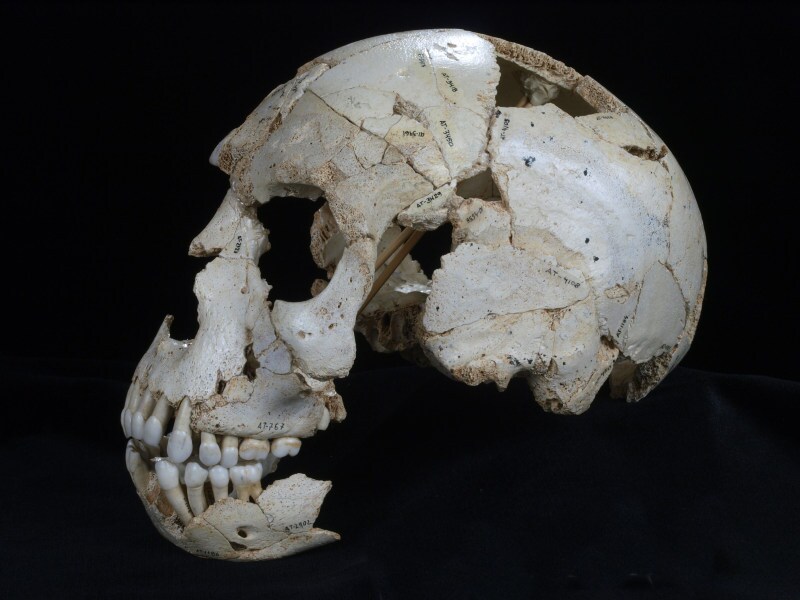 Skull 9. Image courtesy Javier Trueba / Madrid Scientific Films
Skull 9. Image courtesy Javier Trueba / Madrid Scientific Films
______________________________________
Observations like these led the researchers to suggest support for the ‘accretion model’ of Neandertal evolution, or something similar to cladogenesis, wherein evolution takes place through a splitting of species into branches or “clades”, leading to the development of a greater variety of sister species.
However, according to Arsuaga,”we think based on the morphology that the Sima people were part of the Neanderthal clade, although not necessarily direct ancestors to the classic Neanderthals.”
“One thing that surprised me about the skulls we analyzed,” Arsuaga continued, “is how similar the different individuals were. The other fossils of the same geological period are different and don’t fit in the Sima pattern. This means that there was a lot of diversity among different populations in the Middle Pleistocene.”
In other words, because other European Middle Pleistocene fossil specimens found in Europe do not exhibit the suite of features seen in this fossil group, the researchers suggest that more than one evolutionary lineage appears to have coexisted during the European Middle Pleistocene, with that represented by the Sima sample being closer to the Neandertals. The work of Arsuaga et al. suggests that facial modification was the first step in Neandertal evolution, a mosaic pattern fitting the prediction of the accretion model.
Key to the study findings was the homogeneity of the Sima samples. “All of the individuals recovered at the site represent the same biological population which makes it possible for anthropologists to study individual variation as well as sexual differences in the skeleton and patterns of growth and development, among other aspects,” report Arsuaga, et al. in a press release of the Centro Mixto UCM-ISCIII de Evolución y Comportamiento Humano. “While considerable differences in size are apparent within the collection, with some larger skulls and some smaller ones, the anatomical features that anthropologists study to examine evolutionary relationships do not vary much within the Sima population. This combination of mosaic evolution and anatomical homogeneity led the authors to favor a branching pattern of evolution, known as cladogenesis in evolutionary studies, in the European Middle Pleistocene.”
So what species do these Sima fossils represent? The study authors do not assign the fossils to any specific species. But mitochondrial DNA was recently extracted and analyzed from one of the Sima fossils. The results suggest that this population was not a group of “early Neandertals”. Nor, as has been previously suggested, were they representatives of another early human species called Homo heidelbergensis, thought to be ancestral to the Neandertals. The Sima jawbones (mandibles) were observed to be anatomically distinct from that of heidelbergensis.
But there is much more to come from the Pit of Bones.
“With excavations continuing and new fossils being discovered each field season,” report Arsuaga, et al., “there is certainly reason to believe that the Sima de los Huesos will yield more surprising findings in the future.”
A detailed feature article about the work and latest findings at Sima de los Huesos will be published in the upcoming September 2014 issue of Popular Archaeology Magazine.
________________________________________________
Information Sources: Press releases of the Centro Mixto UCM-ISCIII de Evolución y Comportamiento Humano and the American Association for the Advancement of Science
________________________________________________
Read about the most fascinating discoveries with a premium subscription to Popular Archaeology Magazine. Find out what Popular Archaeology Magazine is all about. AND MORE:
On the go? Purchase the mobile version of the current issue of Popular Archaeology Magazine here for only $2.99.
Popular Archaeology’s annual Discovery Edition eBook is a selection of the best stories published in Popular Archaeology Magazine in past issues, with an emphasis on some of the most significant, groundbreaking, or fascinating discoveries in the fields of archaeology and paleoanthropology and related fields. At least some of the articles have been updated or revised specifically for the Discovery edition. We can confidently say that there is no other single issue of an archaeology-related magazine, paper print or online, that contains as much major feature article content as this one. The latest issue, volume 2, has just been released. Go to the Discovery edition page for more information.





